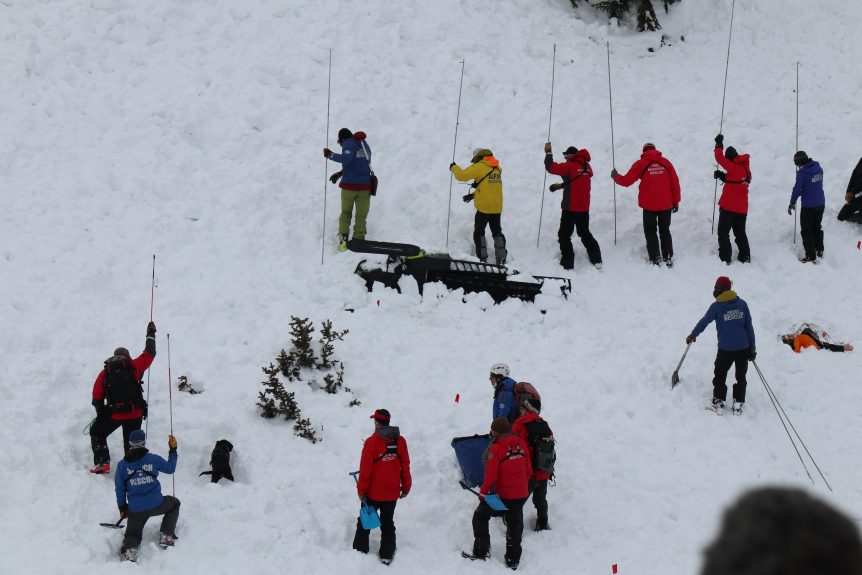In December of 2020, a father and son were snowmobiling from Spring Creek to Elliott’s Ridge, in the far north of Summit County, when they came upon an avalanche with a mangled snowmobile in the toe of the debris field. The key was in it. It didn’t look good.
The two men called 911 and Summit County launched a full response. Flight For Life picked up a dog team and snow tech from Arapahoe Basin ski area and flew them to the top of the ridge above the slide. Another dog team left by vehicle from Breckenridge Ski Area, and a dog team at Beaver Creek Ski Area was put on standby. Twenty-three members of the Summit County Rescue Group left their homes or workplaces as quickly as they could to drive to the scene, some of them with snowmobiles. Two officers from the Summit County Sheriff’s Office also responded with snowmobiles, and Summit Fire and EMS responded with a paramedic. The Colorado Avalanche Information Center was notified and had a person in route, and the US Forest Service was notified.
The owner of the snowmobile turned out to be home, alive and well. He had done the right thing by reporting the avalanche on the CAIC website, but the information had not yet uploaded to the site. We often tell the general public we want them to report avalanches to the county’s 911 dispatch, even when no one is buried in them, but this story helps explain why.
Avalanche notifications result in immediate action for some backcountry search and rescue teams. If a slide is reported to a county’s 911 dispatch with no information as to whether anyone was either buried or injured, the on-call mission coordinator has to assume the worst. Urgency is of utmost importance since survival from a burial is time critical. Although fully buried survivors are rare, we treat all avalanches as though a burial could end up a life saved.
One of the first notifications may be for a helicopter to fly over, if available, to assess for tracks in and out of the slide, whether any personal items are seen on the avalanche debris field like skis or clothing, or to look for someone frantically searching, digging or waving. In some counties, a drone may be used.
At the same time, a Colorado Rapid Avalanche Deployment (C-RAD) team may be placed on standby or even put in the air. During the winter these are generally from a ski area in counties that have them. Outside of ski season, or in counties without ski areas, they will be qualified rescue team members. A C-RAD team consists of a snow technician, dog handler and avalanche search dog.
Depending on the initial flight crew flyover assessment, a C-RAD team may be flown — or they will have to drive — to the area of the avalanche. More than one dog team may be deployed, depending on the size of the slide, taking them away from potentially urgent work at their ski areas.
Meanwhile, the local sheriff’s office will have been notified and the rescue team will place an ‘all call’ for available members to respond. Team members may be dropping everything and leaving home or work, picking up rescue vehicles or driving to the scene in their personal vehicles.
But it doesn’t end there. Depending on the slide location many other agencies may be notified, including the US Forest Service, the Colorado Avalanche Information Center (CAIC), the Colorado Department of Transportation, local ambulance services, the Colorado State Patrol if road closures are considered appropriate, or a property owner depending on the avalanche location.
If the slide is close to another county, or it is particularly large, a team may call CSAR to request assistance from neighboring county search and rescue teams to help with a search and potential recovery operation.
All of these efforts include risk for the responders. Whether driving on icy roads, flying in a helicopter, skiing through avalanche prone terrain, or working on an avalanche field with potential ‘hang fire’ (unreleased snow above the original slide), there are risks we want to minimize or avoid altogether. If you could help us avoid all this risk, wouldn’t you want to?
If you trigger or witness an avalanche, please call your local 911 dispatch to report it, and please also use the CAIC’s online avalanche observation portal or mobile app to report it (https://avalanche.state.co.us/observations/submit-a-report). You could be saving a rescue team and many other agencies a lot of time, risk and expense.
This article was adapted from an article by Charles Pitman that originally ran in the Summit Daily on February 3, 2023. Charles joined the Summit County Rescue Group in 2004 and is one of the team’s ten mission coordinators. He has also served as one of the team’s public information officers and has served on the board of directors.

